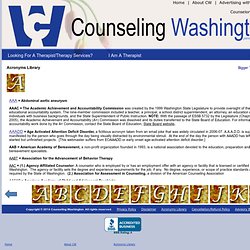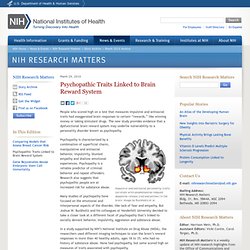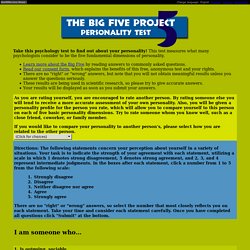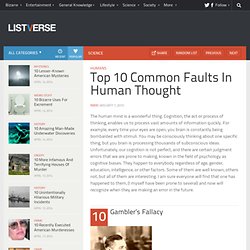

Evolutionary Psychology FAQ. Personality Quiz. Personality Tests. 16 Personality Factors. The Sixteen Personality Factor Questionnaire (or 16PF),[1] is a multiple-choice personality questionnaire which was developed over several decades of research by Raymond B.

Cattell, Maurice Tatsuoka and Herbert Eber. Beginning in the 1940s, Cattell used the new techniques of factor analysis (based on the correlation coefficient) in an attempt to try to discover and measure the source traits of human personality (Cattell, 1946)(Nevid, 2009).[2][3] The questionnaire measures the 16 primary traits, and the Big Five secondary traits,[4][5] which have become popularized by other authors in recent years. From early in his research, Cattell found that the structure of personality was multi-level and hierarchical, with a structure of interdependent primary and secondary level traits (Cattell, 1946, 1957).[2][6] The sixteen primary factors were a result of factor-analyzing hundreds of measures of everyday behaviors to find the fundamental traits behind them. Outline of Test[edit] Mental Health Initials Acronyms and Abbreviations.
AAA = Abdominal aortic aneurysm AAAC = The Academic Achievement and Accountability Commission was created by the 1999 Washington State Legislature to provide oversight of the state’s K-12 educational accountability system.

Acronyms Used by Mental Health and Addiction Therapists Psychotherapists and Social Workers. AAA = Abdominal aortic aneurysm AAAC = The Academic Achievement and Accountability Commission was created by the 1999 Washington State Legislature to provide oversight of the state’s K-12 educational accountability system.

The nine-member commission included a teacher, a principal, a school district superintendent, an attorney, an education researcher, three individuals with business backgrounds, and the State Superintendent of Public Instruction. NOTE: With the passage of ESSB 5732 by the Legislature (Chapter 497, Laws of 2005), the Academic Achievement and Accountability (A+) Commission was dissolved and its duties transferred to the State Board of Education.
For information on the accountability work done by the A+ Commission, contact the State Board of Education, State Board website. AAADD = Age Activated Attention Deficit Disorder, a fictitious acronym taken from an email joke that was widely circulated in 2006-07. AABT = Association for the Advancement of Behavior Therapy ABS = 1.) Acronyms and Abbreviations. Games & Quizzes. Fields of psychology. Life of the Mind. Psychopathic Traits Linked to Brain Reward System - NIH Research Matters. March 29, 2010 People who scored high on a test that measures impulsive and antisocial traits had exaggerated brain responses to certain “rewards,” like winning money or taking stimulant drugs.

The new study provides evidence that a dysfunctional brain reward system may underlie vulnerability to a personality disorder known as psychopathy. Impulsive and antisocial personality traits correlate with amphetamine-induced dopamine release (red and yellow) in the brain. Image by Buckholtz et al. Psychopathy is characterized by a combination of superficial charm, manipulative and antisocial behavior, impulsivity, blunted empathy and shallow emotional experiences. Many studies of psychopathy have focused on the emotional and interpersonal aspects of the disorder, like lack of fear and empathy.
In one experiment, the researchers used positron emission tomography (PET) to image the brain’s dopamine response when participants received a low oral dose of amphetamine. The Big Five Personality Test. Directions: The following statements concern your perception about yourself in a variety of situations.

Your task is to indicate the strength of your agreement with each statement, utilizing a scale in which 1 denotes strong disagreement, 5 denotes strong agreement, and 2, 3, and 4 represent intermediate judgments. In the boxes after each statement, click a number from 1 to 5 from the following scale: Strongly disagreeDisagreeNeither disagree nor agreeAgreeStrongly agree There are no "right" or "wrong" answers, so select the number that most closely reflects you on each statement. Take your time and consider each statement carefully.
How to increase serotonin in the human brain without drugs. Top 10 Common Faults In Human Thought. Humans The human mind is a wonderful thing.

Cognition, the act or process of thinking, enables us to process vast amounts of information quickly. For example, every time your eyes are open, you brain is constantly being bombarded with stimuli. You may be consciously thinking about one specific thing, but you brain is processing thousands of subconscious ideas. Unfortunately, our cognition is not perfect, and there are certain judgment errors that we are prone to making, known in the field of psychology as cognitive biases. The Gambler’s fallacy is the tendency to think that future probabilities are altered by past events, when in reality, they are not. Reactivity is the tendency of people to act or appear differently when they know that they are being observed. Pareidolia is when random images or sounds are perceived as significant. Interesting Fact: the Rorschach Inkblot test was developed to use pareidolia to tap into people’s mental states.
Self-fulfilling Prophecy.